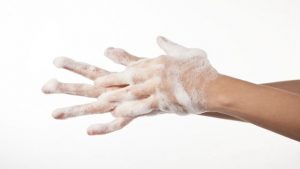Hand hygiene is one of the most effective method for preventing cross-contamination. Food handlers have a major role in the prevention of foodborne illness during food production1 , consequently food handler hand hygiene failures are frequently reported to be implicated in foodborne illness2 . Although informative, food safety cognitions are not indicative of actual practices and may be subject to biases3 , therefore food handlers may demonstrate awareness of food safety, however may fail to translate knowledge into safe practices4 .
 For this reason observational data are superior to survey data5 . However, during direct observations, researcher presence can increase subject reactivity6 , whereas covert video observation provide a more comprehensive analysis over a sustained period, where familiarity reduces reactivity bias7 . Previous video observation research have assessed food handler behaviours at retail/catering settings8-10 , however, this method has been under-utilised in food manufacturing business environments. Covert observation may allow the comparison of practices in different areas of manufacturing over the same period of time.
For this reason observational data are superior to survey data5 . However, during direct observations, researcher presence can increase subject reactivity6 , whereas covert video observation provide a more comprehensive analysis over a sustained period, where familiarity reduces reactivity bias7 . Previous video observation research have assessed food handler behaviours at retail/catering settings8-10 , however, this method has been under-utilised in food manufacturing business environments. Covert observation may allow the comparison of practices in different areas of manufacturing over the same period of time.
A comparison of hand hygiene compliance in high-care and high-risk areas in a Welsh food manufacturing business using covert observation
Cardiff Metropolitan University
Ellen Evans, Catherine Bunston and Elizabeth Redmond
